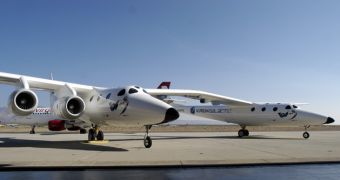One of the most expected events of the year regarding suborbital space tourism took place yesterday at Scaled Composites in Mojave with the unveiling of Virgin Galactic's WhiteKnightTwo, a jet powered carrier aircraft that will act as a launch pad for the SpaceShipTwo suborbital spaceplane. The event signals the beginning of a series of critical tests expected to end by 2010 with the launch of a private space flight service under the supervision of the Virgin Group owned by Sir Richard Branson.
WhiteKnightTwo has two individual fuselages, giving it a catamaran look, a wing span of 42 meters, and should be able to reach a height of 14,600 meters before releasing the SpaceShipTwo spaceplane which will carry 8 people to an altitude of 104,000 meters. "This is a big airplane. It is not an inappropriate claim to say this is the largest all-composite airplane," said Burt Rutan, founder and Chief Technology Officer and Chairman Emeritus of Scaled Composites.
The carrier revealed on Monday was christened 'EVE' and it is equipped with four turbofans that will give it more power than that necessary to carry the SpaceShipTwo to the required height. Also, it has gone though extensive testing to ensure that it is aerodynamically fit to complete its task in launching the spaceplane into a suborbital flight. "I think that's more than you'll find in any other company by a large margin," said Rutan relating to the fact that the latest unveiling is the 40th in the history of Scaled Composites.
"The beauty of WhiteKnightTwo and SpaceShipTwo is that they can help change our relationship with space. The other thing that I admire about the system is that it has the architecture that would someday be developed into passenger carrying vehicle able to take people from A to B around the planet, outside of the atmosphere at near orbital speeds," Branson said following the presentation.
The unveiling of the WhiteKnightTwo is indeed a unique moment for the development of suborbital space tourism, although harder times are still to come, according to Rutan, since until the carrier is tested in flight not much can be said or done about the schedule of the first of the SpaceShipTwo. "You don't know when you're going to be done until you march through the research flight tests," Rutan added. And although the design was not made by Rutan itself, the team of 20 engineers working on it said it could be ready to make its first launch only after 40 test flights. "If everything works... but more than likely we'll run a few more than that," he said.
Virgin Galactic advertises the SpaceShipTwo as a roomy spaceplane with spectacular window views. But this doesn't necessarily mean that the WhiteKnightTwo is a boring plane. Watching it detach from its wing, starting its engines and flying into the heavens should provide an equally exciting experience. "Riding in the launch airplane to watch a launch is going to be a cool thing to do," Rutan pointed out. Additionally, the plane carrier could provide an alternative to the so-called Vomit Comet, being able to generate both microgravity and forces up to seven Gs during a launch.
"For us, this rollout is a really important event. We're going to be flying in a couple of months... ground testing starts almost immediately after this event is over," said Will Whitehorn, president of Virgin Galactic. Whitehorn also added that the WhiteKnightTwo could lift off in as little as two months if the ground evaluations turn out good for the 100 million dollar plane.
As for the SpaceShipTwo, Virgin Galactic officials say that the craft is about 70 percent completed, and could enter the testing stage by the end of 2009. WhiteKnightTwo can also be used as a launching vehicle for satellites and UAVs, or as a means to carry large weights and huge quantities of water to put out fires. "I really think we're on the threshold of a new era of commercial space transportation. This just makes it real... because we've got some hardware coming together and test flying starting. It's going to be an exciting next couple of years," said George Neld of the Federal Aviation Administration's commercial space transportation office.

 14 DAY TRIAL //
14 DAY TRIAL //